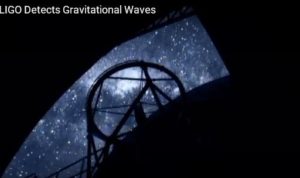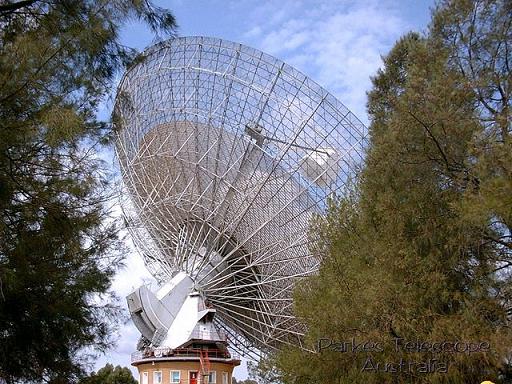Image: The LIGO Livingston [Louisiana] control room as it was during Advanced LIGO’s first observing run (O1). This panoramic was sewn together from several images.

Image: Opened observatory from YouTube Video on page 4 of this article.
What are gravitational waves?
One of the flaws in announcing a new scientific discovery is the problem that the risk that many readers will not have the background to appreciate the meaning of the terms is very high. It is likely for that reason that the very first sentences in the Wikipedia article on “Gravitational Waves” try to establish the definition of such waves:
Not to be confused with “gravity waves.”
Gravitational waves are ripples in the curvature of spacetime that propagate as waves, generated in certain gravitational interactions and travelling outward from their source.
The various descriptions of gravitational and gravity waves on the internet indicate that such waves are unidirectional, and travel until they expend themselves. Gravity waves on earth are mechanical waves which travel through a medium, such as waves on water, or seismic waves generating within the earth. See this Wikimedia article on “Mechanical Waves,” and this Wikimedia article on “Gravity Waves.”
On the other hand, in the Wikipedia article entitled “Gravitational Waves,” that term is said to apply solely to astrophysical gravity waves, which, until April, 2015, had never been measured or seen on earth.
Like earthly gravity waves, gravitational waves are considered unidirectional. But while gravity waves need a medium to move through, gravitational waves travel through space-time. Gravitational wave wavelengths are very long. As pictured at tapir.caltech.edu. The wavelength of gravitational waves appears to end where waves become short enough to be radio waves (at 10 to the 3rd power). While gravity and gravitational waves are analogous to waves on the electormagnetic spectum, waves of the electromagnetic spectrum are bidirectional and able to travel with or without a medium.
One important distinction between gravity waves and gravitational waves is how the two are measured. See the Wikipedia article on “Mechanical Waves,”, as compared to the Wikipedia article on “Gravitational Waves.”
Advanced LIGO officially detected its first gravitational wave September, 2015.
LIGO hadn’t detected gravitational waves since the Laser Interferometer Gravitational-Wave Observatory was officially founded, in 1967. There was a chance this new system would work. Here’s how the event was anticipated by David Shoemaker, Project Leader, on the week of project launch, in September, 2015.
Although earlier LIGO runs revealed no detections, Advanced LIGO, also funded by the NSF [National Science Foundation], increases the sensitivity of the observatories by a factor of 10, resulting in a thousandfold increase in observable candidate objects. “The first Advanced LIGO science run will take place with interferometers that can ‘see’ events more than three times further than the initial LIGO detector,” adds David Shoemaker, the MIT Advanced LIGO project leader, “so we’ll be probing a much larger volume of space.”
See the rest of this article at www.caltech.edu.
In fact, the Advanced LIGO was successful on its first “official” day of operation. Here’s how one scientist experienced that day.
The best thing about a day in my life on the lookout for gravitational waves is that I never know when it will begin.
Like many of my colleagues working for the Laser Interferometer Gravitational-Wave Observatory (LIGO), the morning of Monday, September 14, 2015 caught me completely off-guard.
For years, we’ve been joking that Advanced LIGO would be so sensitive we might just detect one the very first day it turns on. In retrospect, it’s remarkable how close to reality that joke turned out to be.
LIGO is listening for gravitational waves – one of the last unproven predictions of Einstein’s theory of general relativity. In his view of the universe, space and time are fluid things that depend on an observer’s frame of reference. For example, time passes just a (very) little bit more slowly for those who work on the ground floor of an office building as compared to their peers on the 101st floor. Why? They’re deeper in Earth’s gravitational pull.
Einstein predicted that gravitational waves are formed when matter and energy warp space and time. Their effects – until now unseen – sound bizarre. As a gravitational wave passes by, an observer will see the distance between objects change. All around us space is oscillating, distances are changing and we are being stretched and squeezed by passing gravitational waves. Only the most extreme objects in the universe can bend space enough to produce ripples that are measurable here on Earth. The effect is so tiny that we fail to notice it even with the most sensitive measurements – but Advanced LIGO was designed to change all that by directly measuring tiny ripples in space itself.
Although Advanced LIGO had collected data off and on over the summer of 2015, September 14 was slated to be the first official day of its first observing run. From those who built and commissioned the advanced LIGO detectors to those who characterized and analyzed the data, we’d all been preparing for decades to make this kind of discovery, but I don’t know if any of us was truly ready for a detection – and on Day One, as luck would have it.
Hearing what we were listening for
Like others on the team, I should have been woken up in the middle of the night when LIGO heard that first gravitational wave – but it was so early in the run that I hadn’t even had a chance to enable my text message alerts! Instead, I read about the event, termed GW150914, on my phone as I walked to campus hours after it had been observed. It is difficult to describe the level of anticipation regarding a possible event. But I can say that if you have waited for over 12 years for such a discovery, as I have, it certainly is not something to take lightly when it happens.
Like everyone else at the time, though, I thought this signal was just a test of the analysis system, called a hardware injection. I spent the rest of the morning assuming as much. But minutes before a 2:00 p.m. seminar that same day, we received word from each LIGO observatory that no tests had been performed. My student, two postdocs and I all went to our seminar looking like we had seen a ghost! The rest of our colleagues in attendance were not part of LIGO, so we couldn’t say a word. Our silence stood for months to come.
USA-Italy-Germany collaborations
The LIGO Scientific Collaboration (LSC), of which I am a member, is currently made up of more than 1,000 people from dozens of institutions and 15 countries worldwide. There are two LIGO instruments, one in Louisiana and one in Washington. And we work with the Virgo Collaboration that operates a detector in Italy and the GEO600 detector team in Germany. Since we are all so far apart, we met by teleconference so folks who are at the observatories and folks who are analyzing the data could all discuss what was happening and whether or not to share the information more broadly.
To read the rest of this article, visit www.popsci.com.
Image: By Amber Stuver (Own work), via Wikimedia Commons
To hear, and see a visualization of, those first gravitational waves, visit the next page.

